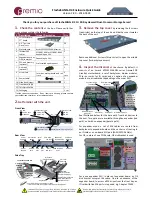
51
cost to the root among the bridges connected to the LAN.
Forward Time (Forward Delay):
This is the maximum time (in seconds) the Switch will wait before changing states. This
delay is required because every switch must receive information about topology changes
before it starts to forward frames. In addition, each port needs time to listen for conflicting
information that would make it return to a blocking state; otherwise, temporary data loops
might result. The allowed range is 4 to 30 seconds.
Max Age:
This is the maximum time (in seconds) the Switch can wait without receiving a BPDU
before attempting to reconfigure. All Switch ports (except for designated ports) should
receive BPDUs at regular intervals. Any port that ages out STP information (provided in
the last BPDU) becomes the designated port for the attached LAN. If it is a root port, a
new root port is selected from among the Switch ports attached to the network. The
allowed range is 6 to 40 seconds.
Hello Time:
This is the time interval in seconds between BPDU (Bridge Protocol Data Units)
configuration message generations by the root switch. The allowed range is 1 to 10
seconds.
PathCost:
Path cost is the cost of transmitting a frame on to a LAN through that port. It is
recommended to assign this value according to the speed of the bridge. The slower the
media, the higher the cost.
How STP Works
After a bridge determines the lowest cost-spanning tree with STP, it enables the root port and
the ports that are the designated ports for connected LANs, and disables all other ports that
participate in STP. Network packets are therefore only forwarded between enabled ports,
eliminating any possible network loops.
STP-aware switches exchange Bridge Protocol Data Units (BPDUs) periodically. When the
bridged LAN topology changes, a new spanning tree is constructed. Once a stable network
topology has been established, all bridges listen for Hello BPDUs (Bridge Protocol Data Units)
transmitted from the root bridge. If a bridge does not get a Hello BPDU after a predefined
interval (Max Age), the bridge assumes that the link to the root bridge is down. This bridge
then initiates negotiations with other bridges to reconfigure the network to re-establish a valid
network topology.
802.1D STP
The Spanning Tree Protocol (STP) is a link layer network protocol that ensures a loop-free
topology for any bridged LAN. It is based on an algorithm invented by Radia Perlman while
working for Digital Equipment Corporation. In the OSI model for computer networking, STP
falls under the OSI layer-2. Spanning tree allows a network design to include spare (redundant)
links to provide automatic backup paths if an active link fails, without the danger of bridge
loops, or the need for manual enabling/disabling of these backup links. Bridge loops must be
avoided because they result in flooding the network.
Содержание NGI-S05C2POE4
Страница 1: ...1 ...
Страница 30: ...30 Power Delay for the range of ports ...
Страница 129: ...129 Apply Click Apply to configure the settings Refresh Click Refresh to begin configuring this screen afresh ...
Страница 131: ...131 Apply Click Apply to configure the settings Refresh Click Refresh to begin configuring this screen afresh ...
Страница 133: ...133 Action Click Delete to remove a configured trap receiver station ...
















































